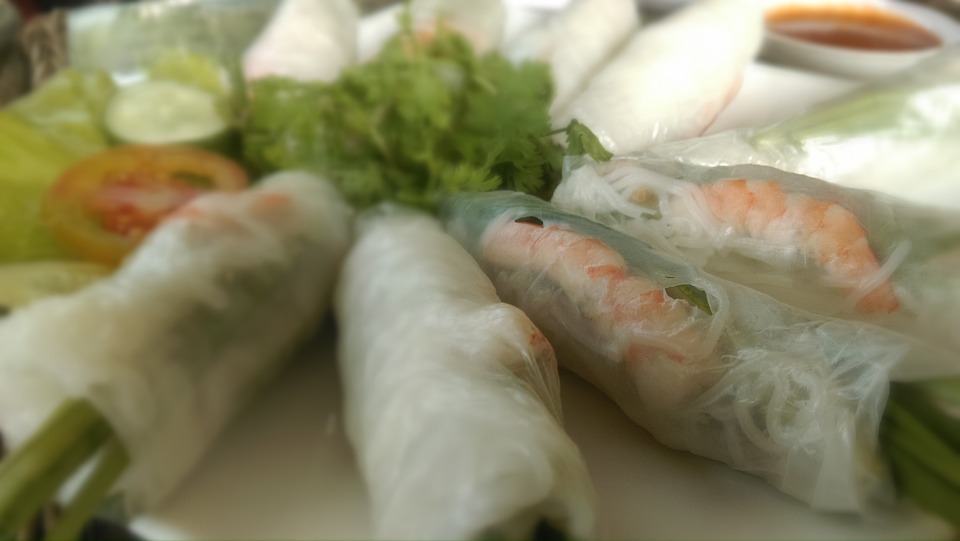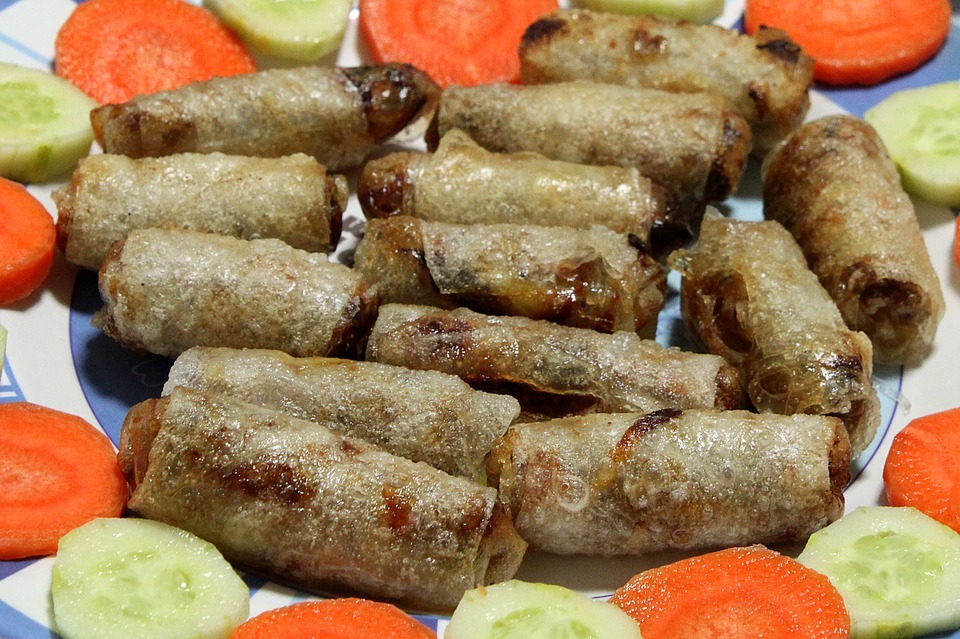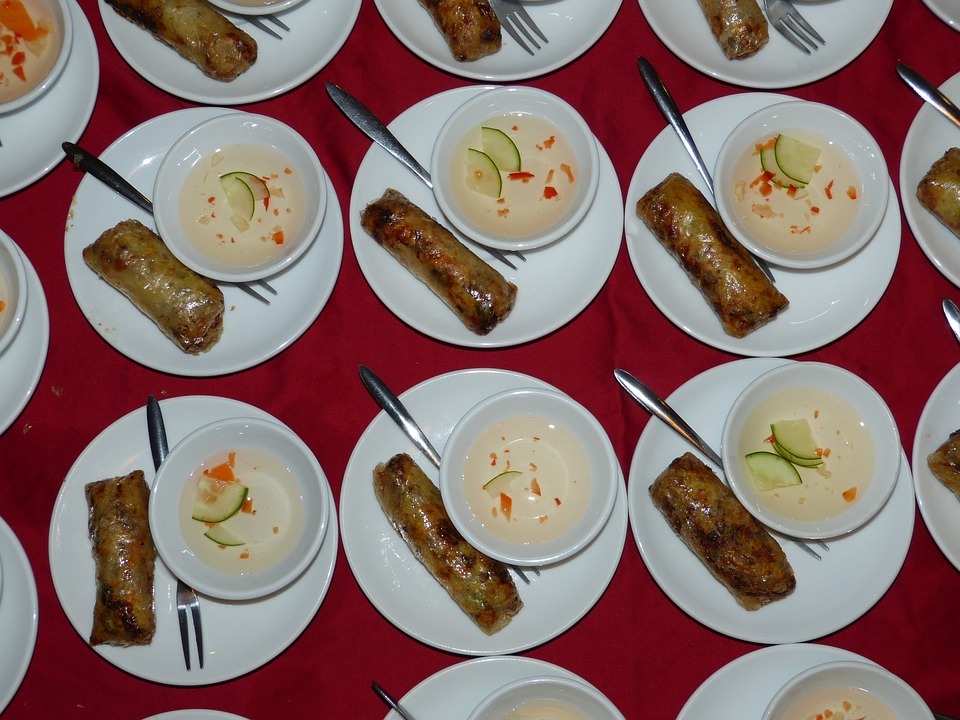Gỏi cuốn, commonly known as Vietnamese fresh spring roll, is a famous dish in southern Vietnam. They are considered as appetizers for much heavier dishes like the pho or the La Vong fried fish.
Vietnamese springs rolls usually consist of cooked prawns, thin rice noodles called bún, and different kinds of vegetables wrapped in a bánh tráng or rice paper. The gỏi cuốn is known for its translucent wrap, where you can see almost every ingredient used inside the roll.
However, the art of wrapping ingredients inside edible wrapper was not invented by the Vietnamese but by the Chinese. How was Vietnam able to adopt this style of preparing food? Let’s find out as we look at the origins of spring rolls.
Origins
The original spring rolls are said to have come from Mainland China. The term spring roll came from the Chinese tradition of using ingredients usually harvested during the spring season and wrapping it into a thin pastry.
These spring rolls are traditionally served during the Spring Festival, popularly known as Chinese New Year. The Spring Festival is celebrated to give respect to their ancestors and give thanks to their deities for a bountiful harvest.
Springs rolls then came to Vietnam when immigrants from China cooked and offered it to their Vietnamese neighbors. The Chinese spring rolls were then modified to able to use ingredients commonly found in Vietnam and to suit the local people’s tastes.
Popular Types of Vietnamese Spring Rolls
Besides modifying the Chinese spring roll to make it more local, several regions in Vietnam have also developed their spin in preparing spring rolls. Here are two of the most popular variants in the country.
Chả giò
Besides the gỏi cuốn, there is another type of spring roll in Vietnam called the chả giò or the fried spring roll. This type of spring roll’s ingredients commonly include uncooked ground pork, chopped vegetables, and mushrooms that are also rolled in rice paper, but this time the roll is deep-fried in oil.
The ground pork used in the fried spring roll can be changed to other types of meat or seafood like chicken, shrimp, and crab. In Northern Vietnam, fried spring rolls with snails inside it are a popular delicacy. Also, vegetarians typically swap the meat with tofu.
There is an obscure variant of the fried spring rolls called chả giò rế where the ingredients are wrapped in bánh hỏi, which are rice noodles that are woven to form a sheet that looks like a rice paper. However, the wrap used in this variant is much more fragile than rice paper, making it harder to cook than the regular fried rice roll. Due to it being difficult to prepare, chả giò rế is usually served only during special occasions.
There are no official recipes as to how to prepare the Vietnamese fried spring rolls, as methods vary from regions or cities that even families have their way of making fried spring rolls. As long as the ingredients are fried inside a wrap, it is considered a chả giò.
Ram Quảng
In Central Vietnam, there is a spring roll dish called Ram Quảng. What’s unique about this type of Vietnamese spring roll is that it uses a whole shrimp with its shell still on it as its primary ingredient.
The shell of the shrimp produces a crispier texture for the spring roll. But not a lot of Vietnamese eat shrimp shells, so that’s why this dish is only prevalent in the central regions of Vietnam.
Sauces Used in Vietnamese Spring Rolls
In Vietnam, people regularly eat spring rolls with dipping sauces. The sauces that are most favored to be paired with spring rolls are tương xào, hoisin peanut sauce, and nước chấm.
The tương xào is a dark brown-colored sauce, which is made from fermented soybeans, salt, water, and glutinous rice. This sauce has a salty taste that balances the spring rolls’ sweetness coming from the shrimps.
Hoisin peanut sauce is made from combining hoisin sauce and peanut butter. The ingredients used in hoisin sauce are red chili peppers, garlic, and soybeans. The Hoisin peanut sauce is both sweet and spicy, which is an excellent complimentary sauce to the spring rolls as it adds flavor to the rice paper wrapping.
Nước chấm is a sauce that mixes fish sauce or nước mắm with lime juice, sugar, and water. Bird’s eye chili peppers are sometimes added to give the sauce a spicy flavor. It has the most complex flavor out of all the sauces mentioned, as it can add sweet, salty, and sour tastes to the spring rolls.
If you go to the different regions of Vietnam, you will discover that there are a lot of unique takes on preparing Vietnamese spring rolls. Some spring rolls can be weirder like the snail fried rolls in Northern Vietnam, while some can be simpler than the others. A few of the variants you may encounter can be as less popular as the gỏi cuốn or the chả giò, but they are guaranteed to offer something new for you taste buds.


